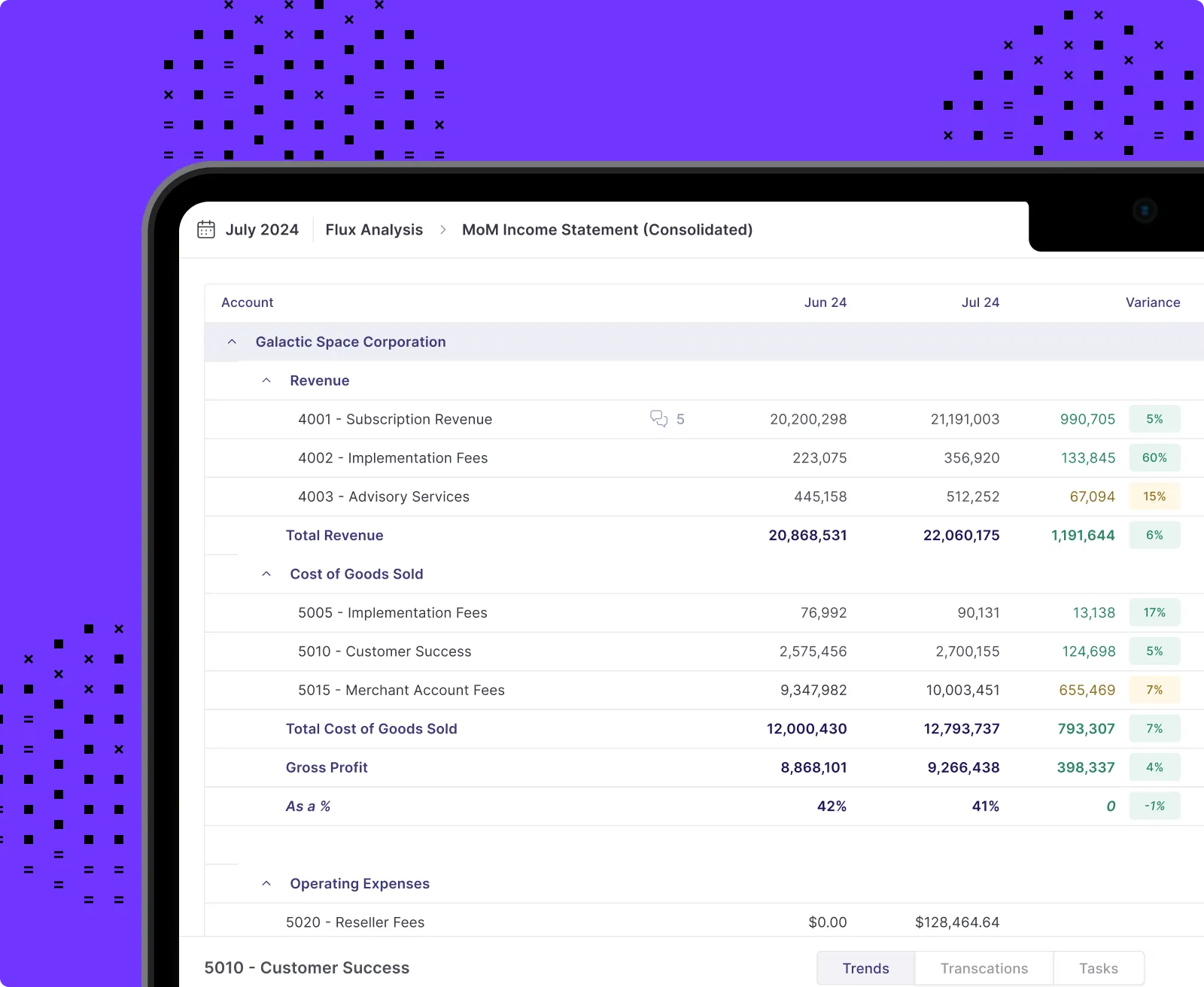The ABCs of SBC: Your Guide to Accounting for Stock-Based Comp
.webp)
Most accountants have a love / hate relationship with stock-based comp.
On a personal level, it’s fantastic to receive and is a big part of the potential upside of joining an earlier stage company.
But zoom out to a company level, and it’s a complete headache to figure out the right accounting treatment and sift through the maze of nuances involved.
Given that stock-based comp certainly isn’t going away anytime soon — we’ve partnered with the technical accounting team at PCG to put together a practical guide on how to account for it, key inputs to keep in mind, and what factors complicate things.
What is stock-based comp?
Before we dive in, let’s define stock-based comp.
Stock-based compensation is when companies reward employees with awards in the form of stock, stock options, or restricted stock units instead of cash, often tied to a particular vesting timeline or conditions.
In practice, stock-based comp is one way to increase the total amount of compensation for an employee without upping the cash flow compensation cost, but instead giving employees ownership in the company.
With a clear stake and potential reward in owning a sliver of the company, incentives are aligned. Employees are directly impacted by the success they helped generate.
Why is accounting for stock-based comp important?
The amount of stock-based comp provided, when, and with what conditions can be a key part of the overall picture of a company’s financial health.
Typically, out of the cash flow statement, balance sheet, and income statement, stock-based comp has the most direct impact on the income statement:
- Decreasing Net Income: Stock-based comp is recognized as a non-cash expense on the income statement. Not including material stock-based comp can inflate net income.
- Impact on Earnings Per Share (EPS): When stock options are exercised, there are internal reporting impacts as well, including often a complex, typically dilutive, impact on EPS.
Auditors will also typically scan the entirety of your cap table during an audit and, depending on company stage and the auditor involved, not having the right accounting for stock-based comp can be a painful, lengthy process to fix.
Guidance on Stock-Based Comp
Guidance on stock-based comp is covered in ASC 718, outlining two key principles that we’ll dive into further:
- Stock-based comp expenses are recognized over the requisite service period. For awards with service-based vesting conditions, this is generally straightforward. Ex. A stock option that vests over 4 years, should be spread out over those years and not recorded as a lump sum expense.
- Stock-based comp value is measured by the fair value as of the grant date.
Fortunately, US GAAP and IFRS are fairly aligned on the topic of stock-based comp, with IFRS providing guidance in IFRS 2, Share Based Payment.
Guidance on stock-based comp for non-employees
How should stock provided to partners, board members, and advisors be taken into account?
While there used to be substantial differences in accounting principles for stock options for employees and non-employees, fortunately the accounting standards for both groups have been largely aligned with FASB’s adoption of ASU 2018-07.
At least one aspect of stock-based comp is straightforward!
What makes stock-based comp so complicated?
We wrote this guide for a reason. Stock-based comp is a thorny topic that many accountants avoid digging into for years.
Much of the complication exists because —
1) Companies provide stock-based comp in a variety of ways (restricted stock, stock options, employee stock ownership plans, long-term incentive plans, stock appreciation rights, employee stock purchase plans, etc.) and with different time-, performance- and market-based vesting conditions.
In this guide we focus on the most common types of stock grants (restricted stock and stock options) and vesting conditions (time-based and performance vesting). Beyond these types and conditions, things begin to get even more complicated and we recommend talking directly with technical experts.
2) Getting the inputs right for valuing stock-based comp can be tricky and ambiguous.
Key Inputs for Stock-Based Comp
Now into the actual accounting of stock-based comp. To get things right, you’ll need to identify a few specific inputs.
- The Type of Award
- Vesting Conditions and Vesting Schedule
- Grant Date
- Fair Market Value of the Award
1. Type of Award
First, isolate whether the award in question is restricted stock units, stock options, or another compensation type (we’ll focus on RSUs and options in this guide given their prominence).
Restricted Stock Units
Restricted Stock Units (RSUs) or restricted shares represent an employer’s promise to give actual shares to employees when certain conditions are met. Typically, they vest when the units are held for a specific period of time or if the company meets certain performance goals. Unlike stock options, employees don’t need to pay anything to exercise their RSUs. In essence, RSUs are like a gift with strings attached.
Stock Options
Stock options, on the other hand, provide an ‘option’ to purchase shares at a later date at a set price (exercise price) in the future. Employees don’t own the shares until they have exercised their options.
When accounting for stock-based comp, both types are valued at the grant date and are recognized as an expense over the vesting period. From a financial reporting perspective, the key accounting difference comes into play with how the award is valued (for RSUs, fair market value, whereas for options, typically an option-pricing model like Black-Scholes is used, taking volatility and other factors into account)— a nuance we cover when outlining the journal entries required.
2. Vesting Conditions and Vesting Schedule
You’ve identified the type of award. Next, determine the relevant vesting conditions and the vesting schedule. Typically, vesting conditions fall into two different categories: performance conditions or service (time-based) conditions.
Service Conditions
The most common type of stock-based comp falls into this camp, typically companies will have stock options vest over 4 years working at the company. The accounting treatment then recognizes the expense over the duration of the service period.
You’ll need to note—
- Service Period: The length of time required before the award fully vests.
- Vesting Start Date: The vesting start date is the date when the employee begins to provide the requisite service to vest their award. This is the date on which stock-based comp expense begins to accrue. For example, an option award granted to a new employee will generally have a vesting start date representing the day they started working for the company.
Many award packages follow a “1-year cliff” vesting schedule, which means that the employee granted the stock-based award must remain with the company for at least one year before they vest into the first 25% of their award (assuming a 4 year service period). After the first year, vesting might continue on a monthly or quarterly basis. - Expiration Date: When the option expires, meaning the last day the award holder can exercise the option to buy underlying shares. Typically 10 years from the grant date.
Performance Conditions
The other common case is performance-based vesting. Think tying employee stock options to hitting a sales quota. In an ideal world, the right accounting treatment is to vest based on the likelihood of the performance condition coming true over a particular time period when the condition could occur.
Where it’s feasible to pull historical data on the likelihood of the condition being true (ex. historic quota attainment in a year), recognize expenses on a straight-line basis based on expectations and then adjust up or down based on what is actually achieved.
But in practice, most companies using performance-based conditions have little historical data to predict the likelihood of conditions being met. For example, it’s hard to estimate with any real confidence when and if a company will go public.
For many companies, performance-based conditions are simply recognized as an expense when and if the condition comes true.

3. Grant Date
The next key variable is the grant date, which dictates the point in time when the valuation of the award is determined.
ASC 718 outlines what constitutes a grant date in fairly in-depth detail, with the overarching principle being that the grant date is when both the employer and the employee have agreed upon the key terms for stock-based comp (the number of shares/options, vesting schedule, exercise price, conditions).
In most cases, this is when the board of directors has officially approved the stock-based comp.
Keep in mind that if an employee signs an offer without a clear strike price and the strike price (or another key term like vesting schedule) is later determined by the board or another entity, then the date that the final condition is determined is the “grant date”.
4. Fair Market Value of the Award
The grant date is critical because it’s used to determine the fair market value of awards. How is fair market value determined?
Fair Market Value of the Award for Public Companies
Calculating the fair market value for public companies is, in most cases, relatively straightforward. The value of a restricted stock unit is the trading price of the share on the public markets as observed on the grant date.
Fair Market Value of the Award for Private Companies
Things are a bit more complicated for private companies. Since there is no public market for their shares, a company can’t directly observe and measure their stock price or volatility. Accountants at private companies need to rely on valuation experts and get a 409A valuation.
409A Valuations
A 409A valuation is an appraisal of the fair market value of the common stock of a private company performed by a qualified independent third party.
Companies are required to get a 409A valuation annually to be compliant with tax laws and regulations, or more frequently if material events occur (such as a financing event, a significant acquisition, or significant changes to revenue or the addressable market).
As the company grows (often as they prepare to go public), 409A valuations are recommended to be obtained more frequently, ideally on a quarterly basis.
The price of a share of common stock calculated in the 409A report is then used as an input into the Black-Scholes model.
Valuing Stock Options
The Black-Scholes Model
While the trading price or 409A report establishes the value of common stock, there’s a difference between common stock value and what options are valued at. To calculate the FMV for options, teams typically use the Black-Scholes model with the following inputs:
- Current stock price (i.e., the observed price for a public company, or the independent appraisal from the 409A report)
- Strike price (the exercise price approved by the board)
- Expected term of the option
- Risk-free rate (mainly the U.S. treasury rates) over the expected term
- Expected volatility of the company’s stock price over the expected term
Remember to validate that the Black-Scholes option is the correct valuation model to use - some vesting conditions on awards (such as the achievement of a defined stock price) may require a more complex valuation model.
If you’re using a software like Carta to manage your cap table, you’ll provide inputs and the software will calculate the option’s FMV for you. Otherwise, teams use excel sheets to model the value of options using the Black-Scholes (or other appropriate) valuation model.
Journal Entries for Stock-based Comp
Armed with key details, including the stock type, vesting conditions and schedule, grant date, and FMV, you’re now prepared to make journal entries.
Journal Entry for Stock Options
When accounting for stock options, as the stock vests (beginning with the vesting start date), you’ll debit stock comp expenses and credit to APIC - Stock Comp.
This entry should be made at least annually, but more frequently (generally monthly or quarterly) for public companies or those that plan to go public soon.
You’ll make a similar entry (debiting expense and crediting APIC) each time until the options are fully vested. Generally, you can expect these entries to continue as awards continue to be issued during new hire and performance review cycles.
Example: Stock options were granted with a 4-year vesting schedule on January 4th, 2024. The fair market value of the options at the grant date is $40,000.
As of the end of Year 1: December 31, 2024
Debit: Stock-Based Compensation Expense: $10,000
Credit: Additional Paid-In Capital - Stock Options: $10,000
This entry recognizes the expense for the first year of the vesting period. The expense is calculated as $40,000 total FMV divided by the 4-year vesting period.
Years 2-4 will have similar entries until the full amount is vested.
Journal Entry if Options are Exercised
If the options are exercised, you’ll debit to cash for the payment at the exercise price. Then reverse out the APIC - Stock Comp with a debit given that the equity is no longer options and credit the par value* of the stock.
Finally, the residual amount will be a credit to the APIC- Common Stock account.
Example:
- Debit: Cash: $64,000 (8,000 shares x $8 strike price per share)
- Credit: Common Stock (at $1 par value*): $8,000 (8,000 shares at $1 each)
- Credit: Additional Paid-In Capital - Common Stock: $56,000 (cash received less the par value of common stock)
This entry reflects the receipt of cash from the employee when they exercise their options (8,000 shares at the $8 exercise price) on the exercise date and the issuance of new stock. The amount credited to common stock is based on the par value, and the remainder goes to additional paid-in capital.
*Par value is the face value of a bond or a share of stock, typically set in the company charter and largely important for tax reasons.
Forfeiture of Stock Options
If an employee leaves before options are vested, they “forfeit” the options. If they left ahead of any options vesting, no action is required.
If they left when options were partially vested, then accounting treatment involves reversing the expense recognized for the portion of the unvested options that were forfeited.
Companies are required to either estimate for forfeitures as expense is recognized, or account for forfeitures as they occur. Most companies elect an accounting policy to account for the forfeitures as they occur as it is operationally easier to manage.
Example:
First, let's calculate the expense recognized until the employee leaves:
- Hire Date: July 1, 2024
- Total Options Granted: 4,000
- Vesting Schedule: Annual (1,000 options vest on the anniversary of the hiring date)
- Grant Date FMV (Total Stock Compensation Expense over 4 years): $40,000
- Annual Expense: $40,000 / 4 = $10,000 per year
On December 31, 2024, the company recorded $5,000 in stock-based comp expense.
On January 1, 2025, the employee departed from the company. Assuming a 1-year cliff in any of their stock options, you would need to reverse the expense recognized for the portion of the award that was expected to vest at the end of the first year.
Upon forfeiture, you would reverse the unvested portion of the expense already recognized:
- Debit: Additional Paid-In Capital - Stock Options: $5,000 (representing the fair value of the forfeited portion for which expense has been recognized but did not vest)
- Credit: Stock-Based Compensation Expense: $5,000
This entry reverses the expense related to the forfeited options. The debit to "Additional Paid-In Capital - Stock Options" offsets the amount that was previously recognized in equity for the options that are no longer expected to vest due to the employee's departure. Note that the first year's options have fully vested which means that portion is not reversed when the employee departs the company.
The credit to "Stock-Based Compensation Expense" reverses the expense previously recorded in the income statement for these options.
Stock Options Expiration
And what if the stock options aren’t exercised and expire? For stock options that expire, the expense is typically not reversed as the options were granted and the requisite services were provided therefore no reversing journal entry is required.
Journal Entry for Restricted Stock Units
Like stock options, RSUs are accounted for as vesting conditions are met.
Keep in mind, the key difference between RSUs and options is the value of the award. Unlike stock options which are based on a valuation model (typically the Black-Scholes model), the value of RSUs is typically the market value of the stock at the grant date (typically the share price on the public market or the 409A value calculated by the independent appraiser).
Example:
Assume that a company begins accounting for restricted stock when the stock begins to vest and:
- The RSU vests after 4 years of continuous service
- The fair value of the RSU on the grant date is $100,000
At the end of Year 1:
Debit: stock-based Compensation Expense: $25,000
Credit: Additional Paid-In Capital - RSUs: $25,000
This entry recognizes the expense for the first year of the vesting period. The contra equity account reflects the company's obligation to provide the underlying shares to the employee.
The same thing will happen until the full restricted stock has vested.
Once fully vested, the RSU is typically settled in shares (with a debit to APIC - RSUs, and credits to common stock at the par value, a APIC - Common Stock for the residual).
Forfeiture of Restricted Stock
If an employee is terminated or leaves prior to the restricted stock vesting, the RSU is forfeited. In this case, similar to stock option forfeitures, a journal entry reverses the expense and the equity recorded for the unvested portions of the RSUs with a debit to APIC - RSUs and a credit to stock-based Compensation Expenses.
Where things get complicated
We’ve covered the basics of accounting for stock-based comp, but there’s still plenty of other complicating factors. While the above guidance is helpful in the majority of cases, we recommend phoning an accounting friend (that’s a strong technical accountant) when the following cases come into play:
- Frequent modification of stock options (here’s a strong outline from Carta)
- Options to purchase instruments other than common stock
- Options to purchase instruments of another company’s common stock
- Profit interests or management incentive awards (common for LLCs)
- Vesting of equity awards based on a market condition
- Anytime there is substantial personalization of stock grants — it’s simpler when the vesting schedule, conditions, and stock type remain constant.
When is it critical to account for stock-based comp?
We’ve established that accounting for stock-based comp is a key part of accurate financial reporting.
Yet, as a small but mighty team ourselves, we completely hear you on competing priorities and limited bandwidth.
You’re wondering when tackling stock-based comp should rise to the top of the list of action items for your accounting team.
Like most things, it’s all about materiality. Key questions to think through as you determine the relative priority of getting stock-based comp up to par:
- How much stock-based compensation have you issued?
- Is an exit (of any kind, acquisition, IPO, etc.) on the horizon?
- Are you preparing for an audit? Who are your auditors?
- Are there tax impacts that are meaningful? Talk with a tax advisor about the impact on share-based compensation.
Generally speaking, given the income statement implications, accounting for stock-based comp matters the more that you’re actively issuing it and your proximity to any exit event.
And if you’re working with a Big 4 firm or similar auditors, they’ll be paying close attention to stock-based comp. Other auditors focused on earlier stage companies may be comfortable with simply taking into account outputs from a software like Carta. As always, checking in with an auditor never hurts and can save significant time to dial in on the right fidelity level for your business.
Finally, stock-based comp, like many topics in accounting, is similar in practice to doing the dishes. If done routinely early on (right after dinner), it’s fairly manageable. But avoid it for a week (or years in the stock-based comp case), and it piles up to a near insurmountable volume.
Striking the right balance between bandwidth and being proactive is key, keeping in mind that the longer the “dishes” pile up, the more challenging catching up will be.
On what cadence should you account for stock-based comp?
The gold star cadence for stock-based comp is incorporating it into your month-end close process. For some teams given bandwidth constraints, quarterly or once a year is more realistic.
Related Reading: How to Build the Best Month-End Close Checklist
Practically, how are teams managing stock-based comp?
So absent all of the high-level guidance, how are real teams handling equity compensation?
While handling stock-based comp in an Excel sheet is possible in the early days, eventually most companies migrate to using a tool like Carta that keeps track of the cap table and helps with stock-based comp.
For large companies, typically an equity specialist is added to the team to handle stock-based comp at scale. In early stages, stock-based comp is typically added to the plate of whoever on the finance and accounting side is managing payroll.
On a monthly or quarterly basis, accountants add to Carta, other tools, or excel any new stock awards once the board has approved, inputting the grant date, vesting schedule, etc.
It’s also important to check with your legal team to understand who “owns” the cap table. For early-stage companies, external legal counsel often handles this step. However, they aren’t accountants and they sometimes make mistakes.
Managing Stock Awards in Carta
After you’ve submitted inputs for an award, Carta calculates the fair value of options using the Black-Scholes pricing model.
To then make the journal entry adjustments for stock-based comp, accountants:
- Ensure all terminations are reflected in Carta, cross referencing their HRIS
- Ensure all stock comp modifications are reflected in Carta, keeping an open line with legal/HR
- Ensure all new issued stock is reflected in Carta
Then accountants download the summarized report, which typically aggregates stock-comp by department, and create the relevant journal entry adjustments in the GL.
For reconciliation, teams reference the cumulative stock comp expense accumulated in equity in the Carta report with the corresponding equity account (a sub-account of additional paid-in capital).
Sticking Points with Carta
Ultimately, Carta’s estimate for stock-based comp is only as strong as the inputs. To be reliable and avoid a hassle come audit season when auditors review the cap table, it’s key to reference an up-to-date 409A, use the correct grant date, and account for any unique vesting conditions.
In Summary
Stock-based comp includes a lot of nuance, but largely revolves around two underlying principles — stock-based comp is expensed over time as it vests and the value is established at the grant date.
By focusing on the two principles and isolating the stock grant type, vesting schedule and conditions, grant date, and fair market value, teams are one step closer to accurate financial statements and avoiding audit headaches down the road.

















.png)
.png)
.png)